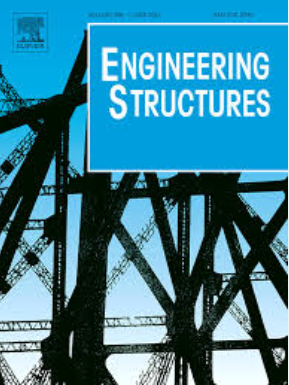玄武岩FRP格栅作为抗剪钢筋的FRP增强混凝土梁的抗剪性能
IF 6.4
1区 工程技术
Q1 ENGINEERING, CIVIL
引用次数: 0
摘要
本研究提出横向连续玄武岩FRP (BFRP)格栅作为抗剪钢筋,自密实海水海砂混凝土作为浇筑材料,以克服传统FRP箍筋的局限性。在四点弯曲条件下,对8个跨深比(λ)在1.5 ~ 2.5之间的梁试件进行了剪切试验,以探讨其剪切性能,特别是拱作用。通过破坏模式、裂缝形态、荷载-挠度响应和荷载-应变关系分析了BFRP网格层和梁高的影响。所有试件均表现出剪切压缩破坏,但安装BFRP网格或降低λ比可减缓临界对角裂纹扩展并延迟破坏。跨中荷载-挠度曲线呈双线上升趋势。BFRP格栅、较低的λ比和较大的梁高增强了第二上升段的斜率,其中λ减小的影响最为显著,因为抵抗机制从梁作用转变为拱作用。尺寸效应在初始斜剪开裂后出现,在斜剪开裂过程中更为明显。在设计规范中,CSA S806-12提供了最接近的抗剪承载力预测,所有试件的平均误差为25.7 %。研究结果强调了BFRP网格改善frp钢筋混凝土梁抗剪性能的潜力,并证明了λ比和梁高度对结构性能的影响。这项研究为优化frp增强混凝土结构提供了见解,特别是在海洋环境中。本文章由计算机程序翻译,如有差异,请以英文原文为准。
Shear behavior of FRP-reinforced concrete beams with basalt FRP grids as shear reinforcements
This study proposes transversely continuous basalt FRP (BFRP) grids as shear reinforcement and self-compacting seawater sea-sand concrete as casting material to overcome limitations of conventional FRP stirrups. Eight beam specimens with shear span-to-depth ratios (λ) ranging from 1.5 to 2.5 were tested under four-point bending to explore shear performance, especially focusing on arch action. The effects of BFRP grid layers and beam heights were analyzed through failure modes, crack patterns, load-deflection responses, and load-strain relationships. All specimens exhibited shear-compression failure, but installation of BFRP grids or reduced λ ratios slowed critical diagonal crack propagation and delayed failure. Mid-span load-deflection curves showed bi-linear ascending behavior. BFRP grids, lower λ ratios, and greater beam heights enhanced the slope of the second ascending segment, with λ reduction having the most significant impact due to a shift of resisting mechanism from beam action to arch action. Size effect tended to emerge after the initial diagonal shear cracks, becoming more pronounced during diagonal cracking. Among design codes, CSA S806–12 provided the closest shear capacity predictions, with an average error of 25.7 % for all specimens. The findings highlight the potential of BFRP grids to improve shear performance of FRP-reinforced concrete beams, and demonstrate the influences of λ ratios and beam height on structural behavior. This study offers insights into optimizing FRP-reinforced concrete structures, particularly in marine environments.
求助全文
通过发布文献求助,成功后即可免费获取论文全文。
去求助
来源期刊

Engineering Structures
工程技术-工程:土木
CiteScore
10.20
自引率
14.50%
发文量
1385
审稿时长
67 days
期刊介绍:
Engineering Structures provides a forum for a broad blend of scientific and technical papers to reflect the evolving needs of the structural engineering and structural mechanics communities. Particularly welcome are contributions dealing with applications of structural engineering and mechanics principles in all areas of technology. The journal aspires to a broad and integrated coverage of the effects of dynamic loadings and of the modelling techniques whereby the structural response to these loadings may be computed.
The scope of Engineering Structures encompasses, but is not restricted to, the following areas: infrastructure engineering; earthquake engineering; structure-fluid-soil interaction; wind engineering; fire engineering; blast engineering; structural reliability/stability; life assessment/integrity; structural health monitoring; multi-hazard engineering; structural dynamics; optimization; expert systems; experimental modelling; performance-based design; multiscale analysis; value engineering.
Topics of interest include: tall buildings; innovative structures; environmentally responsive structures; bridges; stadiums; commercial and public buildings; transmission towers; television and telecommunication masts; foldable structures; cooling towers; plates and shells; suspension structures; protective structures; smart structures; nuclear reactors; dams; pressure vessels; pipelines; tunnels.
Engineering Structures also publishes review articles, short communications and discussions, book reviews, and a diary on international events related to any aspect of structural engineering.
 求助内容:
求助内容: 应助结果提醒方式:
应助结果提醒方式:


